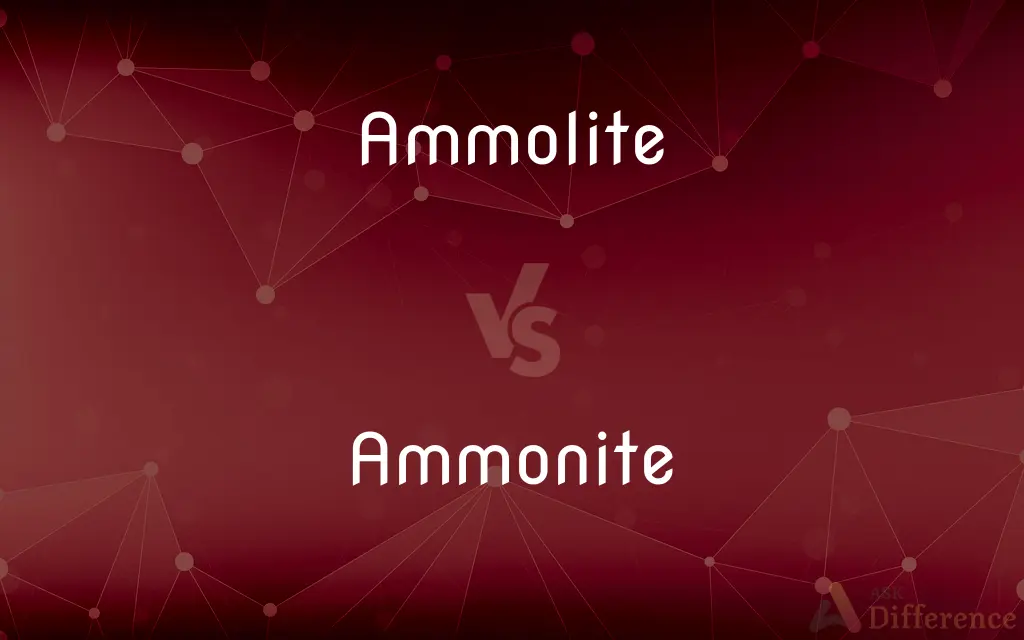Ammolite vs. Ammonite — What's the Difference?
By Maham Liaqat & Fiza Rafique — Updated on May 2, 2024
Ammolite is an opal-like organic gemstone derived from fossilized shells of ammonites, which are extinct marine mollusks; ammonites themselves are the fossils, not the gemstone.

Difference Between Ammolite and Ammonite
Table of Contents
ADVERTISEMENT
Key Differences
Ammolite is a rare, gem-quality fossilized shell of certain ammonite species, prized for its iridescent colors. On the other hand, ammonite refers to the fossilized shells of extinct marine mollusks that lived in the seas between 240 - 65 million years ago.
The gemstone ammolite is primarily composed of the mineral aragonite, which can display brilliant and iridescent colors when light refracts through its microscopic layers. Whereas ammonites are fossils that have turned to stone over millions of years, often retaining the shell’s original structure but not the color.
Ammolite's main source is the Bearpaw Formation in Alberta, Canada, where it is mined and processed into gemstones. In contrast, ammonite fossils can be found worldwide, with significant finds in places like Morocco, Russia, and the UK.
The iridescence of ammolite is due to the microstructure of the shell, which diffracts light into various colors, making each piece unique. Meanwhile, ammonites are valued by paleontologists and collectors for their aesthetic spiral shells and their importance in studying geological history.
Ammolite is used in jewelry and as decorative pieces, often fetching high prices due to its rarity and beauty. However, ammonites are collectible fossils that are sought after for scientific study and as collectible items, with some large and well-preserved specimens also commanding high prices.
ADVERTISEMENT
Comparison Chart
Nature
Gemstone derived from fossilized ammonite shells
Fossilized remains of extinct marine mollusks
Composition
Primarily aragonite with iridescent coloration
Calcite, pyrite, or other minerals, typically non-iridescent
Source
Mainly Bearpaw Formation, Alberta, Canada
Worldwide in sedimentary rock formations
Usage
Jewelry and decorative items
Collectibles, educational specimens, and ornaments
Appearance
Iridescent, multicolored, opal-like
Typically retains the original spiral shell structure
Compare with Definitions
Ammolite
This gemstone is relatively soft, with a hardness of 4.5 on the Mohs scale.
Due to its softness, ammolite is often given a protective coating when used in jewelry.
Ammonite
Ammonites lived during the Jurassic and Cretaceous periods.
Ammonites thrived in the oceans that existed during the time of the dinosaurs.
Ammolite
Ammolite is one of the few biogenic gemstones, originating from organic material.
The organic origins of ammolite make it a favorite among gem collectors.
Ammonite
Ammonite fossils are popular among collectors and are often polished to reveal their inner chambers.
The polished ammonite displayed a beautiful natural pattern that was once the creature’s chambers.
Ammolite
Ammolite is a colorful, iridescent gemstone made from fossilized ammonite shells.
The necklace featured a stunning piece of ammolite with vibrant shades of green and red.
Ammonite
Ammonites are ancient marine fossils with a distinctive spiral shell.
The ammonite fossil he found was perfectly preserved, showcasing the intricate spiral.
Ammolite
Ammolite can display a full spectrum of colors, akin to opals.
The ammolite’s play of color was mesmerizing under the store lights.
Ammonite
A member of a Semitic people inhabiting ancient Ammon, mentioned frequently in the Bible.
Ammolite
The rarity of ammolite enhances its value significantly.
High-quality ammolite can fetch prices comparable to fine opals.
Ammonite
The Semitic language of the Ammonites.
Ammolite
Ammolite is an opal-like organic gemstone found primarily along the eastern slopes of the Rocky Mountains of North America. It is made of the fossilized shells of ammonites, which in turn are composed primarily of aragonite, the same mineral contained in nacre, with a microstructure inherited from the shell.
Ammonite
An extinct cephalopod mollusk of the order Ammonitida of the Permian to Cretaceous Periods, having a thick, usually coiled shell characterized by intricate suture patterns where the septa between individual chambers join the outer shell wall.
Ammolite
A rare and valuable opal-like gemstone, made of the fossilized shells of ammonites.
Ammonite
An ammonoid.
Ammonite
(paleontology) Any of an extinct group of cephalopods of the subclass Ammonoidea; a fossil shell of such an animal.
Ammonite
An explosive prepared from a mixture of TNT and ammonium nitrate; a form of amatol, popular in Eastern Europe and China.
Ammonite
A fossil cephalopod shell related to the nautilus. There are many genera and species, and all are extinct, the typical forms having existed only in the Mesozoic age, when they were exceedingly numerous. They differ from the nautili in having the margins of the septa very much lobed or plaited, and the siphuncle dorsal. Also called serpent stone, snake stone, and cornu Ammonis.
Ammonite
One of the coiled chambered fossil shells of extinct mollusks
Ammonite
These fossils are important for dating geological periods.
The presence of ammonite fossils helped scientists determine the age of the rock layer.
Ammonite
Their shells can vary widely in size, from a few centimeters to over a meter.
He marveled at the museum’s giant ammonite, which was larger than a car tire.
Common Curiosities
What is ammolite?
Ammolite is a gemstone formed from the fossilized shells of certain ammonites, known for its iridescence.
How is ammolite different from ammonite?
Ammolite is a gemstone made from the aragonite layers found in some ammonite fossils, known for its iridescence, whereas ammonite refers to the actual fossilized remains of the mollusks themselves.
Where is ammolite found?
Ammolite is primarily found in the Bearpaw Formation in Alberta, Canada, which is the main source of high-quality gem-quality material.
How old are ammonite fossils typically?
Ammonite fossils date from about 400 million years ago to 66 million years ago, spanning from the Devonian period through to the end of the Cretaceous period.
What are ammonites?
Ammonites are the fossilized shells of extinct marine mollusks that lived from the Devonian through the Cretaceous periods.
Why are ammonite fossils important to science?
Ammonite fossils provide crucial insights into the geological and evolutionary history of the Earth, helping scientists understand ancient marine environments and the diversification of marine life.
What colors does ammolite display?
Ammolite can display a range of colors, including red, green, blue, and violet, often in vibrant and iridescent patterns.
Can ammolite be used in regular jewelry?
Yes, ammolite is used in jewelry, but due to its relative softness and brittleness, it often requires protective treatments like capping or coating with clear materials.
Are all ammonites capable of becoming ammolite?
Not all ammonites become ammolite; only certain species that lived in the right conditions and whose shells composed primarily of aragonite can turn into ammolite.
How do you care for ammolite jewelry?
Ammolite jewelry should be handled with care to avoid scratches and exposure to harsh chemicals; it is also advisable to store it in a soft, padded container.
Is ammonite mining still active?
While ammonite fossils are collected, there is no "mining" per se; instead, these fossils are often found through paleontological digs or surface collection in areas where sedimentary rocks are exposed.
What makes an ammonite fossil valuable?
The value of an ammonite fossil can depend on several factors, including its size, the quality of preservation, rarity, and the presence of iridescence in species that can produce ammolite.
How are ammonite fossils prepared for display or sale?
Ammonite fossils may be cleaned, polished, and sometimes cut to reveal the internal chambers or to enhance their visual appeal for collectors and educational purposes.
Share Your Discovery

Previous Comparison
Haptic vs. Tactile
Next Comparison
Amber vs. GoldAuthor Spotlight
Written by
Maham LiaqatCo-written by
Fiza RafiqueFiza Rafique is a skilled content writer at AskDifference.com, where she meticulously refines and enhances written pieces. Drawing from her vast editorial expertise, Fiza ensures clarity, accuracy, and precision in every article. Passionate about language, she continually seeks to elevate the quality of content for readers worldwide.











































